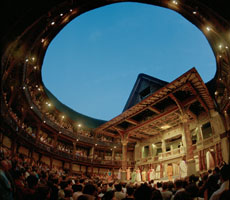
Image copyright: the globe
Some shows are staged with all-male casts as they would have been during Shakespeare's time. Tours are offered throughout the day year-round, although there is no access to the theater during the season's matinee performances.The most expensive seats in the house were those known as the Lords Rooms. They were located immediatedly above and behind the stage in the area also used by the musicians. Although such a location may not seem ideal to the modern day theatregoer, these seats had a number of key advantages to the rich of the day. First, they were well removed from the masses in the rest of the theatre. Second, they were themselves on display, so they could show off the latest fashions, and even the fact that they were rich enough to sit there. Third, although they could not see the play very well, they could hear it. This last point is actually extremely significant, since it was to hear plays that Elizabethans went to the theatre; there are many references of people going to hear a play rather than going to see one in the literature of the time. It is from this concept that the modern word audience is derived. Places in the Lords Rooms would have cost 6 pennies each.Shakespeare himself was an actor as well as playwright and probably taylored a few of his roles to suit his own stage skills. It was however neither his writing, nor acting skills that were the direct source of his income, for actors and playwrights were both poorly paid positions to hold. Instead it was because he was a good businessman and held a share in the company itself. Although without his writing skills they would not have done nearly so well.The actors that performed were William Shakespeare
Richard Burbadge (Burbage)
John Hemings (Heminges)
Augustine Phillips
William Kempt (Will Kempe)
Thomas Poope (Pope)
George Bryan
Henry Condell
William Slye
Richard Cowly
John Lowine
Samuell Crosse
Alexander Cooke
Samuel Gilburne
Robert Armin